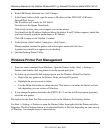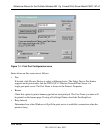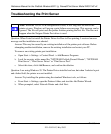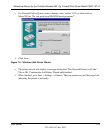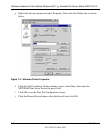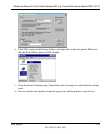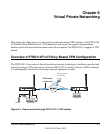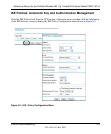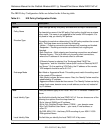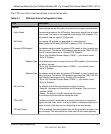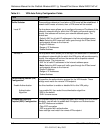
Reference Manual for the ProSafe Wireless 802.11g Firewall/Print Server Model FWG114P v2
8-2 Virtual Private Networking
201-10301-02, May 2005
Using Policies to Manage VPN Traffic
You create policy definitions to manage VPN traffic on the FWG114P v2. There are two kinds of
policies:
• IKE Policies: Define the authentication scheme and automatically generate the encryption
keys. As an alternative option, to further automate the process, you can create an IKE policy
which uses a trusted certificate authority to provide the authentication while the IKE policy
still handles the encryption.
• VPN Policies: Apply the IKE policy to specific traffic which requires a VPN tunnel. Or, you
can create a VPN policy which does not use an IKE policy but in which you manually enter all
the authentication and key parameters.
Since the VPN policies use the IKE policies, you define the IKE policy first. The FWG114P v2
also allows you to manually input the authentication scheme and encryption key values. In the case
of manual key management there will not be any IKE policies.
In order to establish secure communication over the Internet with the remote site you need to
configure matching VPN policies on both the local and remote FWG114P v2 Wireless Firewall/
Print Servers. The outbound VPN policy on one end must match to the inbound VPN policy on
other end, and vice versa.
When the network traffic enters into the FWG114P v2 from the LAN network interface, if there is
no VPN policy found for a type of network traffic, then that traffic passes through without any
change. However, if the traffic is selected by a VPN policy, then the IPSec authentication and
encryption rules will be applied to it as defined in the VPN policy.
By default, a new VPN policy is added with the least priority, that is, at the end of the VPN policy
table.
Using Automatic Key Management
The most common configuration scenarios will use IKE policies to automatically manage the
authentication and encryption keys. Based on the IKE policy, some parameters for the VPN tunnel
are generated automatically. The IKE protocols perform negotiations between the two VPN
endpoints to automatically generate required parameters.
Some organizations will use an IKE policy with a Certificate Authority (CA) to perform
authentication. Typically, CA authentication is used in large organizations which maintain their
own internal CA server. This requires that each VPN gateway has a certificate from the CA. Using
CAs reduces the amount of data entry required on each VPN endpoint.



